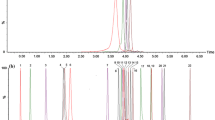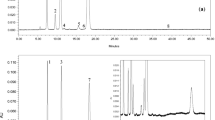Abstract
In this work, a comprehensive two-dimensional liquid chromatography system, comprised of a ZIC-HILIC and C18 columns in the first and second dimensions, respectively, was tuned and employed for attaining high resolution profiles of the polyphenolic pattern in seven commercial berry juices. The developed HILIC × RP-LC method was validated in terms of linearity range, correlation coefficients, limit of detection, limit of quantification, precision (intra- and inter-day), and recovery. A total of 104 polyphenolic compounds belonging to different chemical classes (hydroxybenzoic and cinnamic acid derivatives, flavone glycosides, flavonols, flavonol glycosides, dihydroflavonols, and anthocyanin glycosides) have been characterized and quantified in the juices investigated. Despite the constituents being similar, a notable quantitative variation among the analyzed berry species was observed. Elderberry contained the highest amount of polyphenols (918 ± 1.10 mg 100 mL−1), followed by chokeberry (516 ± 0.08 mg 100 mL−1). On the other hand, raspberry contained the lowest amount (104 ± 1.21 mg 100 mL−1). Further, total phenolic, flavonoid, and anthocyanin contents were determined spectrophotometrically, yielding consistent results. The free-radical scavenging activity (DPPH test) and reducing power of the juices, expressed as IC50 (μL mL−1) and mg ASE mL−1, varied from 2.79 ± 0.03 (honeyberry) to 31.66 ± 0.02 (blueberry) and from 1.71 ± 0.01 (blueberry) to 8.89 ± 0.12 (chokeberry), respectively. Such a ZIC-HILIC × C18 platform based on focusing modulation, never employed so far for berry juices, showed a remarkable separation capability with high values of corrected peak capacity (up to 1372) and orthogonality (Ao up to 0.80), thus providing a great applicability to be advantageously employed for other complex food samples.
Graphical abstract





Similar content being viewed by others
References
Rodríguez-Werner M, Winterhalter P, Esatbeyoglu T. Phenolic composition, radical scavenging activity and an approach for authentication of Aronia melanocarpa berries, juice, and pomace. J Food Sci. 2019;84:1791–8.
Veberic R, Slatnar A, Bizjak J, Stampar F, Mikulic-Petkovsek M. Anthocyanin composition of different wild and cultivated berry species. LWT-Food Sci Technol. 2015;60:509–17.
Stoner GD, Seeram NP. Berries and Cancer Prevention. Spinger; 2011
Marhuenda J, Alemán MD, Gironés-Vilaplana A, Pérez A, Caravaca G, Figueroa F, Mulero J, Zafrilla P. Phenolic composition, antioxidant activity, and in vitro availability of four different berries. J Chem. 2016;2016:1–7.
Mikulic-Petkovsek M, Slatnar A, Stampar F, Veberic R. HPLC-MSn identification and quantification of flavonol glycosides in 28 wild and cultivated berry species. Food Chem. 2012;135:2138–46.
Luís Â, Duarte AP, Pereira L, Domingues F. Interactions between the major bioactive polyphenols of berries: effects on antioxidant properties. Eur Food Res Technol. 2018;244:175–85.
Turkmen N, Sari F, Velioglu YS. Effects of extraction solvents on concentration and antioxidant activity of black and black mate tea polyphenols determined by ferrous tartrate and Folin-Ciocalteu methods. Food Chem. 2006;99:835–41.
Alam MN, Bristi NJ, Rafiquzzaman M. Review on in vivo and in vitro methods evaluation of antioxidant activity. Saudi Pharm J. 2013;21:143–52.
Subbiah V, Zhong B, Nawaz MA, Barrow CJ, Dunshea FR, Suleria HAR. Screening of phenolic compounds in Australian grown berries by LC-ESI-QTOF-MS/MS and determination of their antioxidant potential. Antioxidants. 2021;10:26.
Ciric A, Jelikic-Stankov M, Cvijovic M, Djurdjevic P. Statistical optimization of an RP-HPLC method for the determination of selected flavonoids in berry juices and evaluation of their antioxidant activities. Biomed Chromatogr. 2018;32:4150.
Tulipani S, Mezzetti B, Capocasa F, Bompadre S, Beekwilder J, de Vos CHR, Capanoglu E, Bovy A, Battino M. Antioxidants, phenolic compounds, and nutritional quality of different strawberry genotypes. J Agric Food Chem. 2008;56:696–704.
Grace MH, Xiong J, Esposito D, Ehlenfeldt M, Lila MA. Simultaneous LC-MS quantification of anthocyanins and non-anthocyanin phenolics from blueberries with widely divergent profiles and biological activities. Food Chem. 2019;277:336–46.
Cacciola F, Farnetti S, Dugo P, Marriott PJ, Mondello L. Comprehensive two-dimensional liquid chromatography for polyphenol analysis in foodstuffs. J Sep Sci. 2017;40:7–24.
Cacciola F, Donato P, Sciarrone D, Dugo P, Mondello L. Comprehensive liquid chromatography and other liquid-based comprehensive techniques coupled to mass spectrometry in food analysis. Anal Chem. 2017;89:414–29.
Cacciola F, Dugo P, Mondello L. Multidimensional liquid chromatography in food analysis. TRAC-Trend Anal Chem. 2017;96:116–23.
Česla P, Křenková J. Fraction transfer process in on-line comprehensive two-dimensional liquid-phase separations. J Sep Sci. 2017;40:109–23.
Pirok BWJ, Stoll DR, Schoenmakers PJ. Recent developments in two-dimensional liquid chromatography: fundamental improvements for practical applications. Anal Chem. 2019;91:240–63.
Cacciola F, Rigano F, Dugo P, Mondello L. Comprehensive two-dimensional liquid chromatography as a powerful tool for the analysis of food and food products. TrAC-Trends Anal Chem. 2020;127:115894.
Cacciola F, Arena K, Mandolfino F, Donnarumma D, Dugo P, Mondello L. Reversed phase versus hydrophilic interaction liquid chromatography as first dimension of comprehensive two-dimensional liquid chromatography systems for the elucidation of the polyphenolic content of food and natural products. J Chromtogr A. 2021;1645:462129.
ANVISA-Agência Nacional de Vigilância Sanitária, Resolution – 899 of May 29th, 2003, Brazil, 2003.
Miceli N, Filocamo A, Ragusa S, Cacciola F, Dugo P, Mondello L, Celano M, Maggisano V, Taviano MF. Chemical characterization and biological activities of phenolic-rich fraction from cauline leaves of Isatis tinctoria L. (Brassicaceae) growing in Sicily, Italy. Chem Biodivers. 2017;14:e1700073.
Lee J, Durst RW, Wrolstad RE. Determination of total monomeric anthocyanin pigment content of fruit juices, beverages, natural colorants, and wines by the pH differential method: collaborative study. J AOAC Int. 2005;8:1269–78.
Miceli N, Cavò E, Ragusa S, Cacciola F, Dugo P, Mondello L, Marino A, Cincotta F, Condurso C, Taviano MF. Phytochemical characterization and biological activities of a hydroalcoholic extract obtained from the aerial parts of Matthiola incana (L.) R. Br. subsp. incana (Brassicaceae) growing wild in Sicily (Italy). Chem Biodivers. 2019;16:e1800677.
Rekha C, Poornima G, Manasa M, Abhipsa V, Devi JP, Kumar HTV, Kekuda TRP. Ascorbic acid, total phenol content and antioxidant activity of fresh juices of four ripe and unripe citrus fruits. Chem Sci Trans. 2012;1:303–10.
Toro-Uribe S, Montero L, Lopez-Giraldo L, Ibanez E, Herrero M. Characterization of secondary metabolites from green cocoa beans using focusing-modulated comprehensive two-dimensional liquid chromatography coupled to tandem mass spectrometry. Anal Chim Acta. 2018;1036:204–13.
Sommella E, Pagano F, Salviati E, Chieppa M, Bertamino A, Manfra M, Sala M, Novellino E, Campiglia P. Chemical profiling of bioactive constituents in hop cones and pellets extracts by online comprehensive two-dimensional liquid chromatography with tandem mass spectrometry and direct infusion Fourier transform ion cyclotron resonance mass spectrometry. J Sep Sci. 2018;47:1548–57.
Ji-Liang C, Song-Song W, Hao H, Cheng-Wei H, Jian-Bo W, Huan-Xing S, Yi-Tao W, Peng L. Online comprehensive two-dimensional hydrophilic interaction chromatography × reversed-phase liquid chromatography coupled with hybrid linear ion trap Orbitrap mass spectrometry for the analysis of phenolic acids in Salvia miltiorrhiza. J Chromatogr A. 2018;1536:216–27.
Muller M, Tredoux AGJ, de Villiers A. Application of kinetically optimised online HILIC × RP-LC methods hyphenated to high resolution MS for the analysis of natural phenolics. Chromatographia. 2019;82:181–96.
Arena K, Cacciola F, Mangraviti D, Zoccali M, Rigano F, Marino N, Dugo P, Mondello L. Determination of the polyphenolic fraction of Pistacia vera L. kernel extracts by comprehensive two-dimensional liquid chromatography coupled to mass spectrometry detection. Anal Bioanal Chem. 2019;411:4819–29.
Arena K, Cacciola F, Dugo L, Dugo P, Mondello L. Determination of the metabolite content of Brassica juncea cultivars using comprehensive two-dimensional liquid chromatography coupled with a photodiode array and mass spectrometry detection. Molecules. 2020;25:1235.
Lazzari E, Arena K, Caramão EB, Herrero M. Quantitative analysis of aqueous phases of bio-oils resulting from pyrolysis of different biomasses by two-dimensional comprehensive liquid chromatography. J Chromatogr A. 2019;1602:359–67.
Camenzuli M, Schoenmakers PJ. A new measure of orthogonality for multi-dimensional chromatography. Anal Chim Acta. 2014;838:93–101.
Alasalvar C, Karamac M, Amarowicz R, Shahidi F. Antioxidant and antiradical activities in extracts of hazelnut kernel (Corylus avellana L.) and hazelnut green leafy cover. J Agric Food Chem. 2006;54:4826–32.
Jayaprakasha GK, Ohnishi-Kameyama M, Ono H, Yoshida M, Jaganmohan L. Phenolic constituents in the fruits of Cinnamomum zeylanicum and their antioxidant activity. J Agric Food Chem. 2006;54:1672–9.
Fidelis M, Santos JS, Coelho ALK, Rodionova OY, Pomerantsev A, Granato D. Authentication of juices from antioxidant and chemical perspectives: a feasibility quality control study using chemometrics. Food Control. 2017;73:796–805.
Granato D, Karnopp AR, van Ruth SM. Characterization and comparison of phenolic composition, antioxidant capacity and instrumental taste profile of juices from different botanical origins. J Sci Food Agric. 2015;95:1997–2006.
Jakobek L, Šeruga M, Medvidović-Kosanović M, Novak I. Antioxidant activity and polyphenols of aronia in comparison to other berry species. ACS. 2007;72:301–6.
Konić-Ristić A, Šavikin K, Zdunić G, Janković T, Juranic Z, Menković N, Stanković I. Biological activity and chemical composition of different berry juices. Food Chem. 2011;125:1412–7.
Skupień K, Ochmian I, Grajkowski J. Influence of ripening time on fruit chemical composition of two blue honeysuckle cultigens. J Fruit Ornam Plant Res. 2009;17:101–11.
Bastos C, Barros L, Dueñas M, Calhelha R, Queiroz MJ, Santos-Buelga C, Ferreira I. Chemical characterisation and bioactive properties of Prunus avium L.: The widely studied fruits and the unexplored stems. Food Chem. 2015;173:1045–53.
Acknowledgements
The authors are thankful to Shimadzu and Merck Life Science Corporations for the continuous support. The authors thank Anna Różańska of the Gdansk University of Technology for the supply of the samples.
Author information
Authors and Affiliations
Corresponding author
Ethics declarations
Ethics approval
Not applicable.
Conflict of interest
The authors declare no conflict of interest. Luigi Mondello is editor of Analytical and Bioanalytical Chemistry but was not involved in the peer review of this paper.
Source of biological material
Not applicable.
Statement on animal welfare
Not applicable.
Additional information
Publisher's note
Springer Nature remains neutral with regard to jurisdictional claims in published maps and institutional affiliations.
Published in the topical collection Comprehensive 2D Chromatography with guest editors Peter Q. Tranchida and Luigi Mondello.
Supplementary Information
Below is the link to the electronic supplementary material.
Rights and permissions
About this article
Cite this article
Arena, K., Cacciola, F., Miceli, N. et al. Determination of the polyphenolic content of berry juices using focusing-modulated comprehensive two-dimensional liquid chromatography coupled to mass spectrometry detection. Anal Bioanal Chem 415, 2371–2382 (2023). https://doi.org/10.1007/s00216-022-04216-y
Received:
Revised:
Accepted:
Published:
Issue Date:
DOI: https://doi.org/10.1007/s00216-022-04216-y




